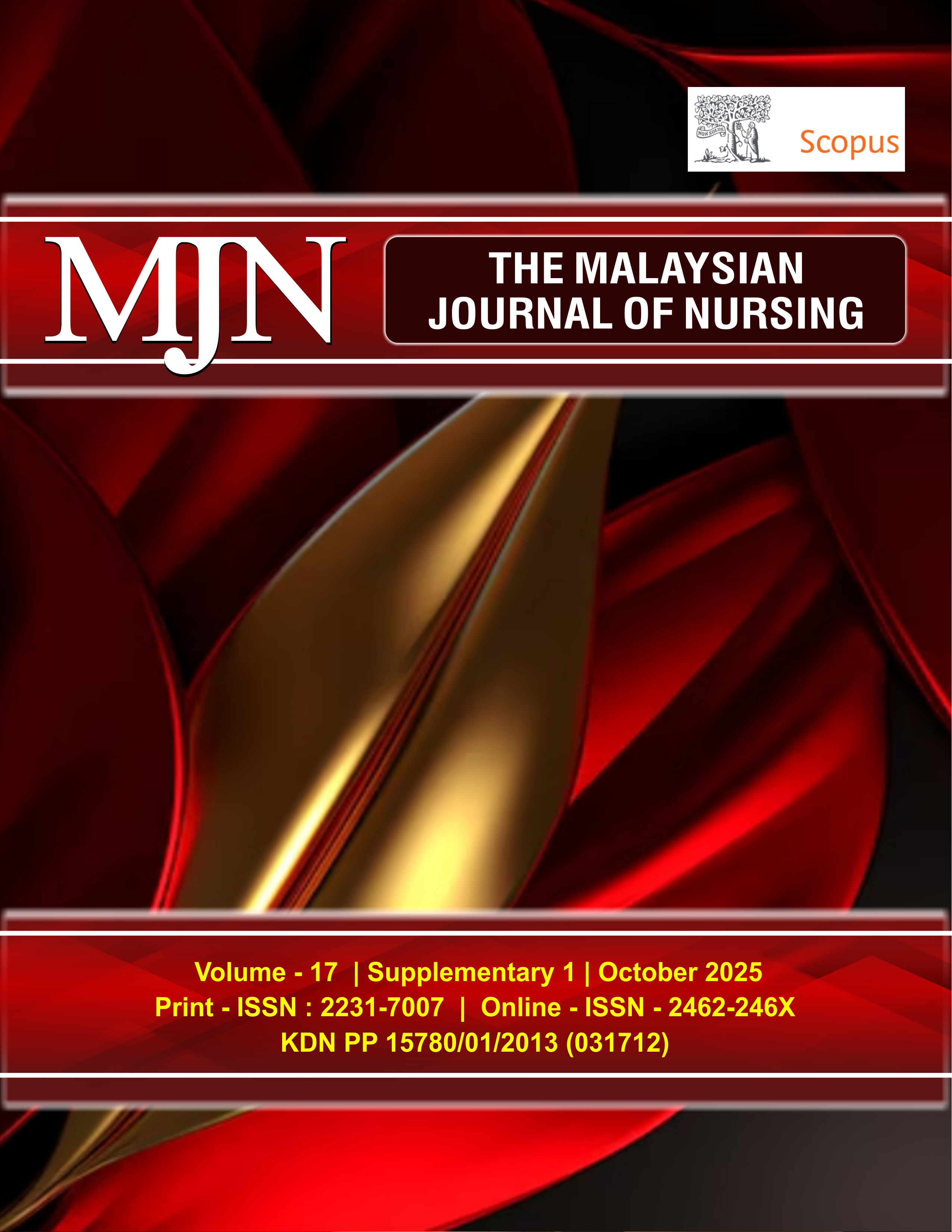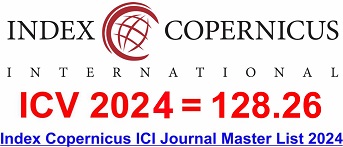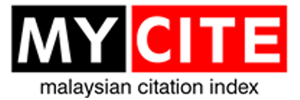Influence of Family Behaviour on Adolescents’ Eating Habits in Karbala City, Iraq
DOI:
https://doi.org/10.31674/mjn.2025.v17isupp1.006Abstract
Background: Teenagers in the age range of 10 to 19 years are in a developmental stage where they experience significant physical and mental growth as they transition from puberty to adulthood. Examining the interpersonal effects that influence health behaviours in the context of parent-adolescent relationships is especially significant and rich. Objectives: To identify the family behaviours concerning adolescents’ eating habits in Holy Karbala city, specifically to find-out the differences in family behaviours and adolescents’ eating habits according to their demographic characteristics. Methods: The study design is cross-sectional and stratified sampling method which was conducted at 373 teenagers aged 10 to 19 years, to assess the “Influence of Family Behaviours on Eating Habits among Secondary School Students” in Holy Karbala city centre at 20 governmental secondary schools in education directorate. Students in secondary schools filled out Eating Habits Questionnaires (EHQs) to provide the data. The questionnaire format comprising two sections was designed to cover all aspects of the study; the section one includes demographic characteristics and section two includes family behaviours. The data collected during May 2024. Results: It revealed that most of adolescents (98.9%) live with their families and less than half of adolescents (48.3%) strongly agrees that they enjoy eating meals with their family, and vast majority of them (92.8%) have good level of family behaviours regarding eating habits. Also, the findings indicated a significant impact of family behaviours on the eating habits of adolescents, particularly in relation to the father's level of education. As well, it demonstrated that the occupation of the father had a significant impact on the family behaviours of adolescents. Conclusion: The investigation reveals that elevated levels of positive family behaviours improve the quality of adolescents’ eating habits. Recommendations through the nurse’s role in educating the families’ adolescents to promote healthier food choices.
Keywords:
Adolescent, Eating Behaviours, Family, Nursing EducationDownloads
References
Alaslani, K., Alroqi, H., Almohammadi, A., Aljahlan, Y., Alsulaiman, R., Albeeshi, A., ... & Alnemary, F. (2025). A national study on knowledge of child language development, self-efficacy, and the professional development of childcare providers in Saudi Arabia. Discover Education, 4(1), 1-28. https://doi.org/10.1007/s44217-025-00460-3
Allcott-Watson, H., Chater, A., Troop, N., & Howlett, N. (2024). A systematic review of interventions targeting physical activity and/or healthy eating behaviours in adolescents: practice and training. Health Psychology Review, 18(1), 117–140. https://doi.org/10.1080/17437199.2023.2173631
Ardakani, A., Monroe-Lord, L., Wakefield, D., & Castor, C. (2024). Enhancing dietary adherence among African-American adolescents: the role of parenting styles and food-related practices. Frontiers in Nutrition, 11. https://doi.org/10.3389/fnut.2024.1254338
Baral, S., Singh, A. K., Aryal, A., Subedi, J., Dhakal, U., & Khanal, A. (2025). Food habit, physical activity and nutritional status of adolescents in selected schools of Madhyapur Thimi municipality, Nepal: A cross-sectional study. PLoS Global Public Health, 5(1). https://doi.org/10.1371/journal.pgph.0004136
Braune, T., Adams, J., & Winpenny, E. M. (2024). Exploring the changing association between parental and adolescent fruit and vegetable intakes, from age 10 to 30 years. International Journal of Behavioral Nutrition and Physical Activity, 21(1). https://doi.org/10.1186/s12966-024-01604-8
Facina, V. B., Fonseca, R. da R., da Conceição-Machado, M. E. P., Ribeiro-Silva, R. de C., Dos Santos, S. M. C., & de Santana, M. L. P. (2023). Association between socioeconomic factors, food insecurity, and dietary patterns of adolescents: A latent class analysis. Nutrients, 15(20). https://doi.org/10.3390/nu15204344
Herdiansyah, D., Setiawan, B., & Tanziha, I. (2025). Comparison of food security and nutritional status among adolescent girls aged 15-19 in highland and coastal areas of Garut Regency, West Java. BIO Web of Conferences. https://doi.org/10.1051/bioconf/202517103012
Heslin, A. M., & McNulty, B. (2023). Adolescent nutrition and health: characteristics, risk factors and opportunities of an overlooked life stage. Proceedings of the Nutrition Society, 82(2), 142–156. https://doi.org/10.1017/S0029665123002689
Hübner, H. L., & Bartelmeß, T. (2024). Associations of sugar-related food parenting practices and parental feeding styles with prospective dietary behavior of children and adolescents: A systematic review of the literature from 2017 to 2023. Frontiers in Public Health, 12. https://doi.org/10.3389/fpubh.2024.1382437
Ibrahim, I. H., & Said, Y. H. (2023). Food security policy in Iraq and the challenges of response after 2003. Tikrit Journal for Political Science, 3(pic4), 287-314. https://doi.org/10.25130/tjfps.v3ipic4.238
Islam, R., Hasan, A. B. M. N., Ferdous, N. J., Sharif, A. Bin, & Hasan, M. (2024). Factors influencing food preferences and eating behaviour among the Forcibly Displaced Myanmar Nationals (FDMN) adolescents in Cox’s Bazar, Bangladesh: A cross-sectional survey. BMJ Public Health, 2(1). https://doi.org/10.1136/bmjph-2023-000237
Ispas, A. G., Forray, A. I., Lacurezeanu, A., Petreuș, D., Gavrilaș, L. I., & Cherecheș, R. M. (2025). Eating disorder risk among adolescents: the influence of dietary patterns, physical activity, and BMI. Nutrients, 17(6). https://doi.org/10.3390/nu17061067
Kalogirou, E., & Gentaz, E. (2025). A scientometric review of the scientific literature on child effects on adults: Topics of interest and areas for development in psychological research. Acta Psychologica, 255. https://doi.org/10.1016/j.actpsy.2025.104897
Kontele, I., Saripanagiotou, S., Papadopoulou, A. M., Zoumbaneas, E., & Vassilakou, T. (2023). Parental dieting and correlation with disordered eating behaviours in adolescents: A narrative review. Adolescents, 3(3), 538–549. https://doi.org/10.3390/adolescents3030038
Liu, K. S. N., Chen, J. Y., Ng, M. Y. C., Yeung, M. H. Y., Bedford, L. E., & Lam, C. L. K. (2021). How does the family influence adolescent eating habits in terms of knowledge, attitudes and practices? A global systematic review of qualitative studies. Nutrients, 13(11). https://doi.org/10.3390/nu13113717
Liu, K. S. N., Chen, J. Y., Sun, K.-S., Tsang, J. P. Y., Ip, P., & Lam, C. L. K. (2023). Family facilitators of, barriers to and strategies for healthy eating among Chinese adolescents: Qualitative interviews with parent–adolescent dyads. Nutrients, 15(3). https://doi.org/10.3390/nu15030651
Liu, X., Zhang, Y., Zeng, J., Jiang, Z., & Liu, Y. (2025). Development of father-and mother-child intimacy and their association with internalizing and externalizing problems among early and Middle Chinese adolescents. Journal of Youth and Adolescence, 54(5), 1326-1339. https://doi.org/10.1007/s10964-025-02139-2
López-Gil, J. F., Victoria-Montesinos, D., Gutiérrez-Espinoza, H., & Jiménez-López, E. (2024). Family meals and social eating behavior and their association with disordered eating among Spanish adolescents: The EHDLA Study. Nutrients, 16(7). https://doi.org/10.3390/nu16070951
Lupu, C. E., Scafa-Udriște, A., Matei, R. S., Licu, M., Stanciu, T. I., Stanciu, G., Hashemi, F., Mihai, A., Lupu, S., & Ene, R. (2025). Adolescent nutritional patterns and health behaviors in Romania: A cross-sectional analysis. Nutrients, 17(9). https://doi.org/10.3390/nu17091448
Maia, C., Braz, D., Fernandes, H. M., Sarmento, H., & Machado-Rodrigues, A. M. (2025). The impact of parental behaviors on children’s lifestyle, dietary habits, screen time, sleep patterns, mental health and BMI: A Scoping Review. Children (Basel, Switzerland), 12(2). https://doi.org/10.3390/children12020203
Majid, S., Foo, S., Luyt, B., Zhang, X., Theng, Y.-L., Chang, Y.-K., & Mokhtar, I. A. (2011). Adopting evidence-based practice in clinical decision making: Nurses’ perceptions, knowledge, and barriers. Journal of the Medical Library Association (JMLA), 99(3). https://doi.org/10.3163/1536-5050.99.3.010
Neumark-Sztainer, D., Larson, N. I., Fulkerson, J. A., Eisenberg, M. E., & Story, M. (2010). Family meals and adolescents: what have we learned from Project EAT (Eating Among Teens)? Public Health Nutrition, 13(7), 1113–1121. https://doi.org/10.1017/S1368980010000169
Okab, A. A., & Jawad, A. K. (2024). Assessment of the nutritional status and associated factors among adolescent girls in preparatory schools at Al-Kut City. Medical Journal of Babylon, 21(4), 858–864. https://doi.org/10.4103/MJBL.MJBL_696_23
Oudat, Q., & Okour, A. (2025). Utilizing the social ecological model to inform nursing practice for improved childhood eating behaviors. Research and Theory for Nursing Practice. https://doi.org/10.1891/RTNP-2024-0169
Rathi, N., Tiwari, P., Kanwar, M., Patel, A., Singh, M., Gupta, K., & Worsley, A. (2025). What influences Indian primary school children’s food behaviors? - Perceptions of children, mothers and teachers. BMC Public Health, 25(1). https://doi.org/10.1186/s12889-025-22660-0
Selman, N. A., Hussain, A. M. A., & Mera, N. A. A. (2024). The prevalence of nutritional status and obesity in adolescents in Babylon Province, Iraq. Medical Journal of Babylon, 21(1), 174–178. https://doi.org/10.4103/MJBL.MJBL_1360_23
Sharobidinovna, A. D., Baxtiyor, S., & Muslimbek, R. (2025). The importance of vitamins and minerals for athletes. Ethiopian International Journal of Multidisciplinary Research, 12(03), 150–153. https://www.eijmr.org/index.php/eijmr/article/view/2741
Sohail, R., Hasan, H., Saqan, R., Barakji, A., Khan, A., Sadiq, F., Furany, S., AlShaikh, Z., Atef Mahmoud, O. A. A., & Radwan, H. (2024). The influence of the home food environment on the eating behaviors, family meals, and academic achievement of adolescents in schools in the UAE. International Journal of Environmental Research and Public Health, 21(9). https://doi.org/10.3390/ijerph21091187
Spaumer, A., & Mavhandu-Mudzusi, A. H. (2025). Pentecostal church leaders’ support to children in need of care and protection. HTS Theological Studies, 81(1), 1–10. https://doi.org/10.4102/hts.v81i1.10173
Svolos, V., Strongylou, D. E., Argyropoulou, M., Stamathioudaki, A. M., Michailidou, N., Balafouti, T., Roussos, R., Mavrogianni, C., Mannino, A., & Moschonis, G. (2025). Parental perceptions about energy balance related behaviors and their determinants among children and adolescents living with disability: A qualitative study in Greece. Healthcare, 13(7). https://doi.org/10.3390/healthcare13070758
Talens, C., da Quinta, N., Adebayo, F. A., Erkkola, M., Heikkilä, M., Bargiel-Matusiewicz, K., ... & Meinilä, J. (2025). Mobile-and web-based interventions for promoting healthy diets, preventing obesity, and improving health behaviors in children and adolescents: systematic review of randomized controlled trials. Journal of Medical Internet Research, 27. https://doi.org/10.2196/60602
Talukdar, R., Ravel, V., Barman, D., Kumar, V., Dutta, S., & Kanungo, S. (2024). Prevalence of undernutrition among migrant, refugee, internally displaced children and children of migrated parents in lower-middle-income countries: a meta-analysis of published studies from last twelve years. Diabetes & Metabolic Syndrome: Clinical Research & Reviews, 18(3). https://doi.org/10.1016/j.dsx.2024.102976
Wu, S. (2024). The Influence of Family Nurturing Environment on Children’s Emotions and Behaviors. International Journal of Education and Humanities, 14, 274–278. https://doi.org/10.54097/ca4kqt80
Yahia, S., Salem, N. A., Tobar, S., Abdelmoneim, Z., Mahmoud, A. M., & Laimon, W. (2025). Shedding light on eating disorders in adolescents with type 1 diabetes: insights and implications. European Journal of Pediatrics, 184(4). https://doi.org/10.1007/s00431-025-06081-0
Yasin, N. D., Hassan, S. M., & Ateye, M. D. (2024). Understanding Adolescent Nutritional Status: A Comprehensive Literature Review. Journal of Food Chemistry & Nanotechnol, 10(1), 26–31. https://doi.org/10.17756/jfcn.2024-171
Zaborskis, A., Grincaitė, M., Kavaliauskienė, A., & Tesler, R. (2021). Family structure and affluence in adolescent eating behaviour: A cross-national study in forty-one countries. Public Health Nutrition, 24(9), 2521–2532. https://doi.org/10.1017/S1368980020003584
Zhang, X., Yan, J., Zhu, W., & Fu, X. (2024). Development and validation of the Chinese family environment influencing physical activity habits scale. Frontiers in Psychology, 14. https://doi.org/10.3389/fpsyg.2023.1243658
Published
How to Cite
Issue
Section
License
Copyright (c) 2025 The Malaysian Journal of Nursing (MJN)

This work is licensed under a Creative Commons Attribution-NonCommercial-NoDerivatives 4.0 International License.



































